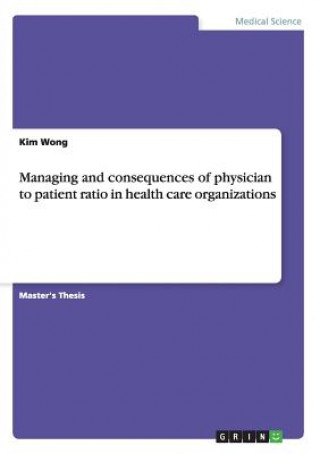
Versand
Kaufberater





Passt nicht? Macht nichts! Bei uns ist die Rückgabe innerhalb von 30 Tagen möglich
 Geschenkgutschein
In einem beliebigen Wert
Geschenkgutschein
In einem beliebigen Wert
Mit einem Geschenkgutschein können Sie nichts falsch machen. Der Beschenkte kann sich im Tausch gegen einen Geschenkgutschein etwas aus unserem Sortiment aussuchen.
Managing and consequences of physician to patient ratio in health care organizations
 Englisch
Englisch
 116 b
116 b
30 Tage für die Rückgabe der Ware
Das könnte Sie auch interessieren


Master's Thesis from the year 2012 in the subject Medicine - Public Health, grade: 2,5, University of Cologne, language: English, abstract: Imbalance between demand for and supply of physicians is an issue regularly addressed by the media, researchers and policy makers. It has been widely spread in many countries for years. Healthcare organizations in both of developed and developing countries have all experienced from that. Physician to patient ratio is one of the important normative population based indicators to measure this imbalance. It equals to the entire number of physicians in a healthcare organization dividing its patient volume within a certain period (e.g., a year). The§quotient is often standardized in form of X (number of physicians) per 1,000 patients, or in form of ''1:X'' in order to express the amount of patients (X) that under one physician's management clearly. In comparison with other measurements, this kind of indicators are less complicated and easier to§comprehend. An imbalance between physician demand and supply in a healthcare organization could be explicitly identified and quantified by comparing its actual physician to patient ratio with a ''gold standard''. Unfortunately, a wide-range§suitable gold standard of physician to patient ratio does not exist. Therefore, healthcare organizations must make great efforts to find their own gold standards. The physician to patient ratio could be easily confounded with the patient to§physician ratio which represents the number of physicians, who oversee one patient within his or her entire hospital stay. In an ideal model for patient care is ''1:1'' the target patient to physician ratio to aim at. But in reality, this ratio is not§easy to realize. In this paper, merely the physician to patient ratio is under discussion.§Imbalance between demand for and supply of physicians could bring inappropriate physician to patient ratio to healthcare organizations. It is one of the major threats to healthcare organizations, as it might have consequences such as lower quality of healthcare services, closure of hospital's ward, increasing wait time, reducing number of staff beds, under-utilization of physicians or higher medical costs. Managing the physician to patient ratio is not only a key to predict these risks but also the hope for turning the imbalance situations into balance ones. [...]
Informationen zum Buch
 Englisch
Englisch
Kategorie


 Kontakt
Kontakt Wie einkaufen
Wie einkaufen



















